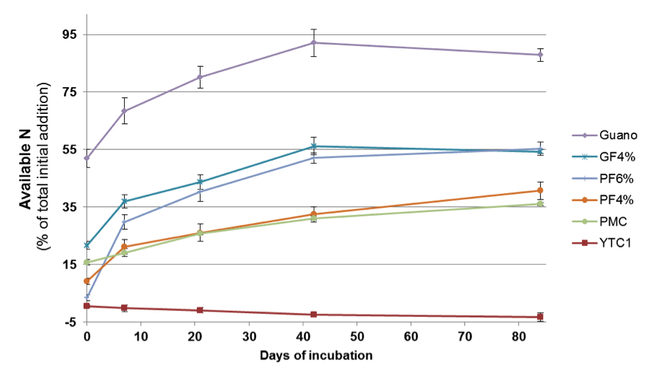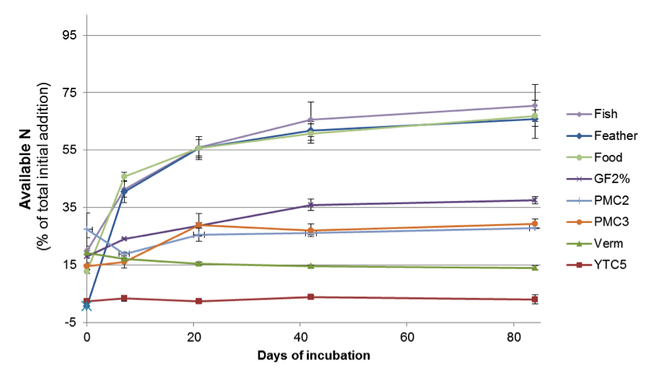Working with the Geisseler Lab at UC Davis, we have been evaluating a number of commonly used organic amendments to understand when the nitrogen (N) applied with various amendments actually becomes available for plant use. We have assembled this graph from our incubation studies, showing nitrogen availability. Although the incubation methods do not necessarily replicate field conditions, they are useful to understand how the amendments behave compared to each other under the same conditions. These relationships are likely to play out similarly on-farm.
This graph can be used to understand 1) how quickly N is released from products and 2) how organic fertilizers, composts and liquid fertilizers compare.
|
ID |
Material |
C:N ratio |
|
Guano |
Pelleted seabird guano, guaranteed analysis 12-12-2.5 |
1.2 |
|
GF4% |
Granular fertilizer, 4% N (poultry manure and fish based) |
6.6 |
|
PF6% |
Pelleted fertilizer (poultry manure, feather meal based) |
5.2 |
|
PF4% |
Pelleted fertilizer (poultry manure, bone meal based) |
7.3 |
|
PMC |
Poultry manure compost, Facility 1 (Spring 2017 batch) |
7.9 |
|
YTC1 |
Municipal yard trimmings compost, Facility 1 |
20.8 |
|
Fish |
Liquid fish emulsion, 2-3-0.5 |
5.2 |
|
Feather |
Feather meal 12-0-0 |
3.8 |
|
Food |
Food-based liquid fertilizer 3-3-2 |
5.2 |
|
GF2% |
Granular fertilizer, 2% N (poultry manure based) |
6.3 |
|
PMC2 |
Poultry manure compost, Facility 2 |
6.8 |
|
PMC3 |
Poultry manure compost, Facility 1 (Oct 2017 batch) |
6.8 |
|
Verm |
Vermicompost, guar. analysis 0.75% N |
13.2 |
|
YTC5 |
Municipal yard trimmings compost, Facility 2 |
13.2 |
Summary
1) All the products show a similar N release curve, except composts. The trend is a spike of rapid release in the first 10 days, followed by a steady release between 10- 40 days, and leveling out to minimal release thereafter*.
2) The amount of N released is highest in seabird guano, feather meal, food-based liquid fertilizer and liquid fish emulsion.
3) Generally, the higher the carbon-to-nitrogen (C/N) ratio, the less readily available plant N.
4) Yard trimmings composts are unlikely to contribute much N fertility in the year they are applied, though they are useful for building long-term soil fertility. Composts with a high C/N ratio may tie up soil nitrogen.
5) All amendments with a steep initial release suggest a relatively high proportion of initial ammonium. This means that a good amount of N is immediately available for plant uptake, and that it's important to incorporate these materials to avoid N loss by volatilization as ammonia.
*Since the amendments were incubated under optimum conditions, the release rates in the field will generally be lower.
Methods
To measure potential nitrogen release rates from different amendments under controlled conditions, we obtained soil from the top 6” of an organically farmed loam soil in the Capay Valley. This soil was mixed with several different amendments at a rate of 300 lbs N/acre, and incubated at optimum moisture at 73°F for 12 weeks.
We are continuing to evaluate products and welcome your suggestions.
Contact: Margaret Lloyd at mglloyd@ucanr.edu

